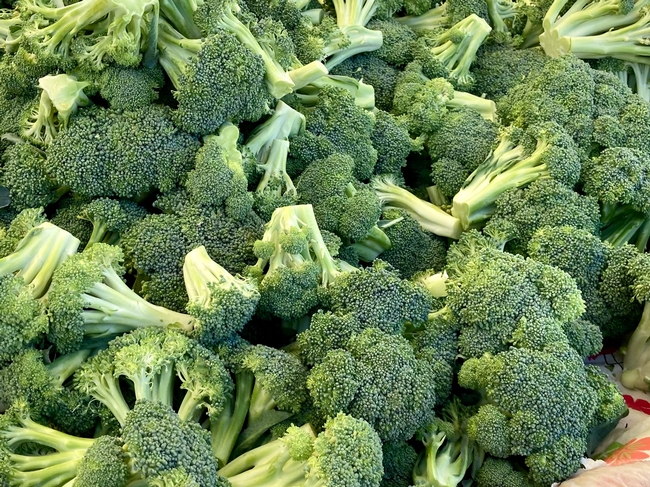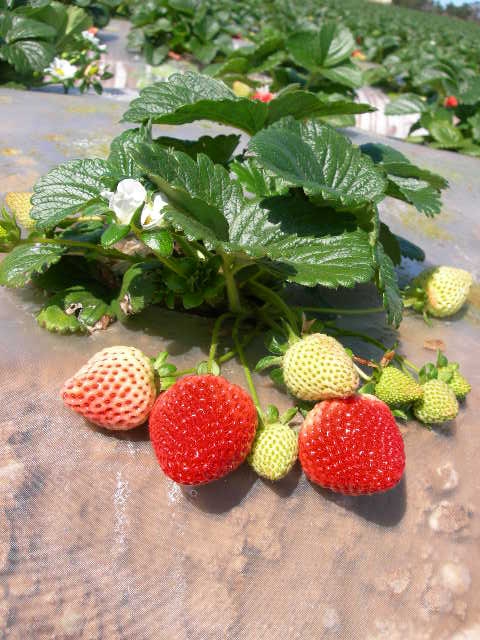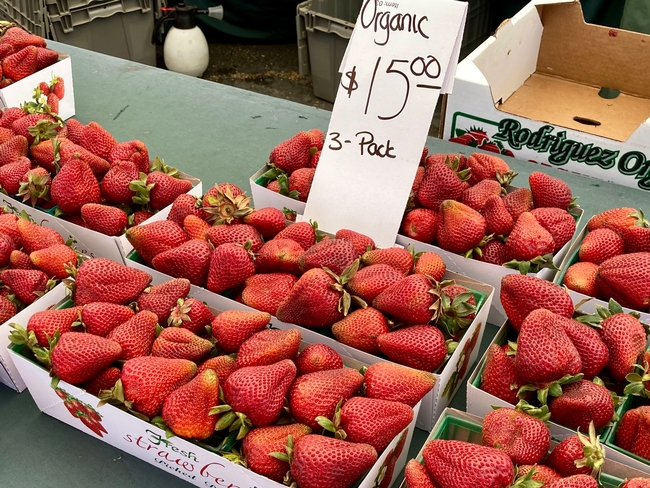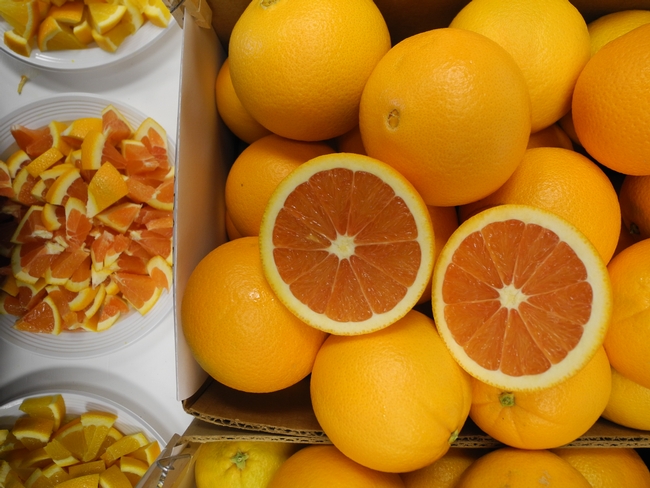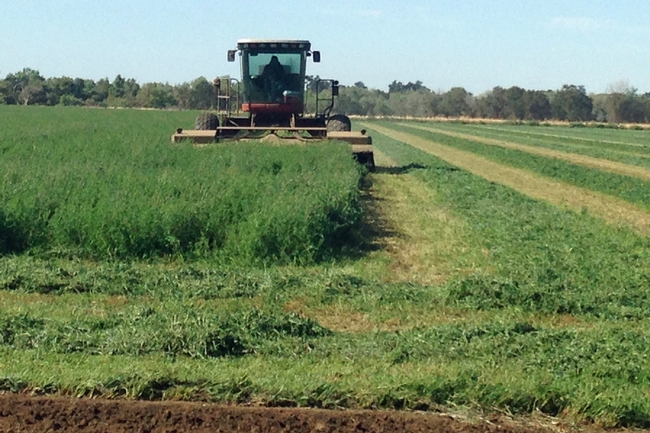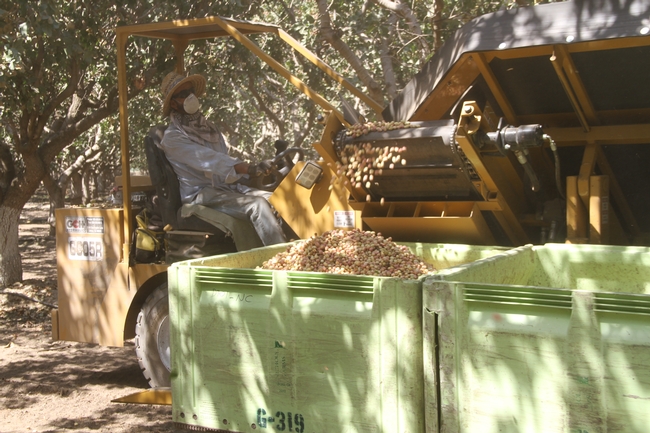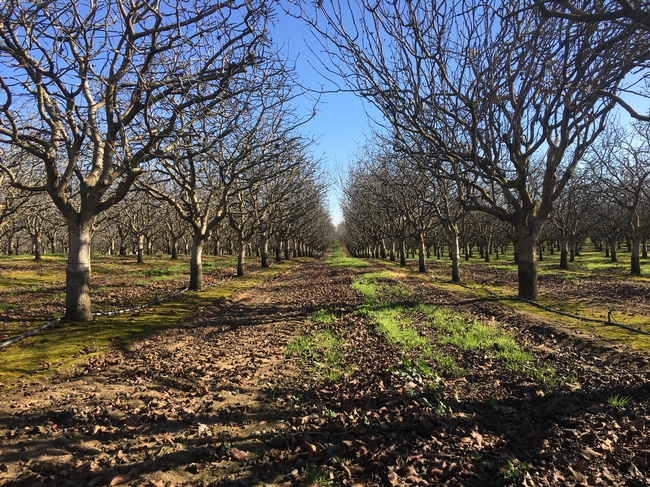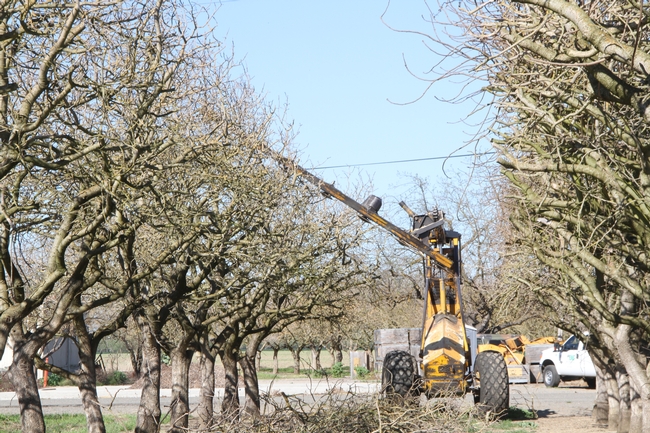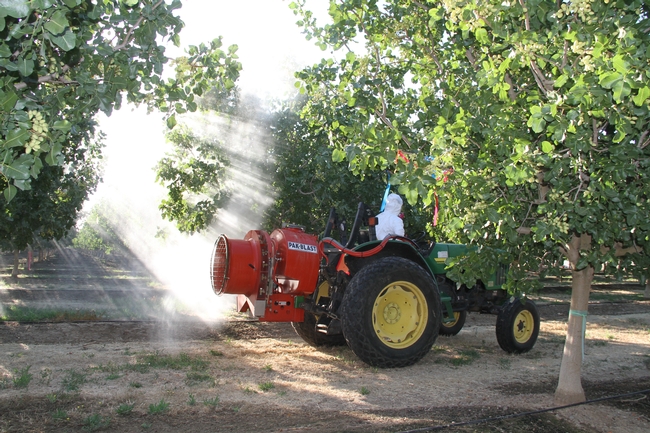Posts Tagged: Cost studies
New UC studies estimate production costs for coastal lettuce, broccoli
California Central Coast growers and others now have help estimating costs and potential returns for growing lettuce and broccoli. Four new cost studies for lettuce and broccoli grown in Santa Cruz, San Benito or Monterey counties have been released by UC Agriculture and Natural Resources, UC Cooperative Extension and the UC Davis Department of Agricultural and Resource Economics.
“These studies provide growers with a baseline to estimate their own costs, which can help when applying for production loans, projecting labor costs, securing market arrangements or understanding costs associated with water and nutrient management and regulatory programs,” said Brittney Goodrich, UC Cooperative Extension specialist and study co-author.
The cost studies model a management scenario for a 1,500-acre coastal vegetable operation, where lettuce and broccoli are rotated with other cool season vegetable and berry crops. Each study describes the cultural practices used to produce each crop including land preparation, soil fertility and pest management, irrigation and labor needs. Harvest costs are also shown.
Six tables show the individual costs of each operation for lettuce and broccoli, material input costs, and cash and non-cash overhead costs in a variety of formats. A ranging analysis shows potential profits over a range of prices and yields.
The 2023 sample cost studies to produce and harvest romaine hearts lettuce, wrapped iceberg lettuce, bunched broccoli and broccoli crowns can be downloaded from the UC Davis Department of Agricultural and Resource Economics website at https://coststudies.ucdavis.edu.
For a detailed explanation of the assumptions and calculations used to estimate the costs and potential returns for each crop, readers can refer to the narrative portion of each study.
Sample cost of production studies for many other commodities grown in California are also available on the website.
For more information, contact the co-authors: Jeremy Murdock in the UC Davis Department of Agricultural and Resource Economics at jmmurdock@ucdavis.edu, or UC Cooperative Extension farm advisors emeriti Laura Tourte at ljtourte@ucanr.edu and Richard Smith at rifsmith@ucanr.edu.
UC study breaks down costs of growing organic strawberries
Thinking about commercially growing organic strawberries on the Central Coast?
To help prospective and current growers evaluate financial feasibility, the University of California has estimated costs to produce and harvest organic strawberries for fresh market in Santa Cruz, San Benito and Monterey counties.
“This revise of the last cost-of-production study incorporates the newest in labor costs along with updates on cultural techniques,” said study co-author Mark Bolda, UC Cooperative Extension strawberries and caneberries advisor in Santa Cruz, San Benito and Monterey counties.
The new study, “Sample Costs to Produce and Harvest Organic Strawberries in the Central Coast Region-2022,” has been released by UC Agriculture and Natural Resources and UC Davis Department of Agricultural and Resource Economics.
The analysis is based on a hypothetical well-managed organic strawberry farm using practices common to the region, but the costs, materials and practices shown in this study will not apply to all farms. Growers, UC Cooperative Extension farm advisors and specialists, pest control advisers and others provided input and reviewed the methods and findings of the study.
“Current growers can use it as a baseline to compare with their own cost and returns estimates to make sure they have an accurate picture of the profitability of their organic strawberry enterprise,” said co-author Brittney Goodrich, UC Cooperative Extension agricultural economics specialist. “Many agricultural lenders use these studies as a baseline to determine whether to approve operating or investment loan requests from current and potential strawberry growers.”
The researchers assume a farm operation size of 30 contiguous acres of rented land, with strawberries are planted on 27 acres. The study includes a list of suitable strawberry varieties for the region, but no specific variety is used in the study. The crop is harvested by hand and packed into trays containing eight 1-pound clamshells from April through early October, with peak harvest in June through August.
The authors describe the assumptions used to identify current costs for production material inputs and cash and non-cash overhead. Ranging analysis tables show net profits over a range of prices and yields. Other tables show the monthly cash costs, the costs and returns per acre, hourly equipment costs, and the whole farm annual equipment, investment and business overhead costs.
The study's expanded section on labor includes information on California's new minimum wage and overtime laws.
“It's reached a wider audience this time through presentations of the material to students at Cal Poly [San Luis Obispo] and also a group of USDA officials at the California Strawberry Commission,” said Bolda.
“All of this just underlines the value of these studies to California growers and others working in agriculture,” Bolda said.
Free copies of this study and other sample cost of production studies for many commodities are available. To download the cost studies, visit the UC Davis Department of Agricultural and Resource Economics website at https://coststudies.ucdavis.edu.
This cost and returns study was funded by the UC Davis Department of Agricultural and Resource Economics.
For additional information or an explanation of the calculations used in the studies, contact Jeremy Murdock, UC Davis Department of Agricultural and Resource Economics, at jmmurdock@ucdavis.edu or UC Cooperative Extension's Bolda at (831) 763-8025.
New UC study outlines costs of growing oranges in the San Joaquin Valley
A new study outlining the costs and returns of establishing and producing navel oranges with low-volume irrigation in the southern San Joaquin Valley has been released by UC Agriculture and Natural Resources, UC Cooperative Extension and the UC Davis Department of Agricultural and Resource Economics.
“A cost study gives a ‘new' grower a better idea of all the costs that are involved with producing the crop,” said co-author Greg Douhan, UC Cooperative Extension citrus advisor for Tulare and Fresno counties.
Real estate agents, land leasers, bankers evaluating loan applications and others can use the cost study to estimate current costs to plant and produce oranges and expected profits.
This study updates an earlier version, using as an example the Cara Cara navel, which is known for its distinctive pink-colored flesh rather than the conventional orange flesh of the Washington navel.
“The Cara Cara has been returning very good prices to growers for the past decade or so and is a relatively new navel,” said co-author Craig Kallsen, UC Cooperative Extension farm advisor in Kern County. “Of course, grower returns are driven by consumer demand. Why consumers like it so much I do not know, but I suspect it is because it tastes good and is different. You cut it and get a pink surprise. Its harvest maturity is similar to that of the Washington navel.”
The updated version takes into consideration “things like inflation, chemical availability, changes in markets both domestic and foreign, governmental regulations and other things,” Kallsen said.
The study is based on a hypothetical farm that consists of 65 contiguous acres onlandin the San Joaquin Valley previously planted to another tree crop. Establishment and production costs are based on 10 acres being planted to oranges. Mature orange trees are grown on 50 acres and the remaining five acres are roads, equipment, shop area and homestead. The grower owns and farms the orchards.
The two major orange varieties grown in the San Joaquin Valley are navels and valencias. Navels are grouped into three types by harvest timing – early, mid and late season. Due to current planting practices, only navels are included in this budget. Cara Cara is the variety of navel oranges currently most commonly planted.
The Cara Cara orange trees are planted double density, 10-by-20-foot spacing, at 218 trees per acre. At this density, it is possible to start harvesting in year 3 or 4. At year 8 or 9, full maturity is achieved and growers begin pruning back every other tree. This allows the grower to maintain yields while at the same time converting the field to 20-by-20 spacing – maximizing yield for a fully mature orchard.
For pest management, the study includes detailed information and links to UC Integrated Pest Management guidelines for citrus. The narrative contains tables of insecticide treatment cycles for establishment and production years.
The section “Exotic Pests of Economic Concern to Citrus Growers” contains information to meet quarantine regulations on exporting oranges from California to countries such as South Korea.
The authors describe the assumptions used to identify current costs for oranges establishment and production, material inputs, cash and non-cash overhead. A ranging analysis table shows profits over a range of prices and yields.
“2021 - Sample Costs to Establish an Orchard and Produce Oranges in the Southern San Joaquin Valley” can be downloaded for free from the UC Davis Department of Agricultural and Resource Economics website at coststudies.ucdavis.edu. Sample cost of production studies for many other commodities are also available for free on the website.
For additional information or an explanation of the calculations used in the studies, refer to the Assumptions section or contact Donald Stewart at (530) 752-4651, destewart@ucdavis.edu or Karen Jetter at (530) 792-8255 or jetter@ucanr.edu. To discuss this study with a UC Cooperative Extension farm advisor, contact your local UC Cooperative Extension office: http://ucanr.edu/County_Offices.
This study was funded in part by the National Institute of Food and Agriculture, U.S. Department of Agriculture, under award numbers 2017-70016-26755 and 2019-70016-29068.
Organic alfalfa hay cost study released
A new study that outlines costs and returns of establishing and producing organic alfalfa hay has been released by UC Cooperative Extension, the UC Agricultural Issues Center and the UC Davis Department of Agricultural and Resource Economics.
High-quality organic alfalfa hay is an important ingredient in milk-cow feed rations for organic dairies. Organic dairy farms are required to use organic feed and allow cows to graze for part of their forage. Organic alfalfa hay comprises a major source of forage for the industry.
In 2019, organic dairy farms in California produced about 900 million pounds of milk — just over 2% of California milk output production, according to co-author Daniel Sumner, director of the UC Agricultural Issues Center and professor in the UC Davis Department of Agricultural and Resource Economics.
“Demand for organic alfalfa production has grown, including demand from dairy, horse, sheep, goat, and beef producers, but is still a small share of total alfalfa production,” said Daniel Putnam, UC Cooperative Extension forage specialist in the Department of Plant Sciences at UC Davis and co-author of the study. “However, understanding organic production methods and costs is very important for California's organic hay farmers.”
The new study estimates the costs and returns of establishing and producing organic alfalfa using flood irrigation in the Sacramento Valley, north and south San Joaquin Valley, and the Intermountain Region. The 100 acres of organic alfalfa is rented for $345 per acre annually and the alfalfa stand life is four years after the establishment year.
Input and reviews were provided by UCCE farm advisors and specialists and growers. The authors describe the assumptions used to identify current costs for organic alfalfa establishment and production, material inputs, cash and non-cash overhead and a ranging analysis table, which shows profits over a range of prices and yields.
“This cost study provides information on how to grow alfalfa hay organically,” said Rachael Long, study co-author and UC Cooperative Extension farm advisor in Yolo County. “The research that went into developing these practices represents a significant investment by UCCE farm advisors and specialists and California alfalfa farmer collaborators. We are pleased to team up with economics and cost study experts to provide this study, which indicates potential profits in growing this crop for the organic dairy market.”
The new study, “Sample Costs to Establish and Produce Organic Alfalfa Hay, California - 2020” can be downloaded for free from the UC Davis Department of Agricultural and Resource Economics website: http://coststudies.ucdavis.edu. Sample cost of production studies for many other commodities are also available on the websites.
For an explanation of calculations used in the study, refer to the section titled Assumptions. For more information, contact Jeremy Murdock, UC Agriculture and Natural Resources, Agricultural Issues Center, Department of Agricultural and Resource Economics, at (530) 752-4651 or jmmurdock@ucdavis.edu. To discuss this study with a local extension advisor, contact the UC Cooperative Extension office in your county: https://ucanr.edu/About/Locations.
Pistachio production costs outlined in UC study
The popularity of pistachios as a healthy snack continues to drive demand. California's pistachio crop was valued at $1.94 billion in 2019, according to the California Department of Food and Agriculture.
For growers considering planting an orchard, the costs and returns of establishing and producing pistachios in the southern San Joaquin Valley are outlined in a new study by UC ANR's Agricultural Issues Center, UC Cooperative Extension and the UC Davis Department of Agricultural and Resource Economics.
“New growers use this information to create their budget for production loans for their bank,” said Jeffrey Gibbons, plant manager of Setton Pistachio of Terra Bella. “Owners use this information so they can be assured their farm managers are not overcharging them for farming costs. Farm managers use this information to see how they compare to the industry. Setton Pistachio uses this information to project budgets for future planting scenarios.”
UC Cooperative Extension specialists and farm advisors routinely refer people interested in planting pistachios to the cost study.
“I use this every time I have a new grower,” said Louise Ferguson, UC Cooperative Extension specialist in the UC Davis Department of Plant Sciences and co-author of the study. “It not only gives a good estimate of establishment and production costs, and projected net returns, but ensures no details are missed in planning. It is an invaluable template for pistachio production.”
Elizabeth Fichtner, UC Cooperative Extension orchard systems advisor for Kings and Tulare counties, agreed. “The cost study documents are one of the first resources I assemble for new growers.”
The new study estimates the costs and returns of establishing and producing pistachios using low-volume drip irrigation in the southern San Joaquin Valley. The hypothetical orchard is planted at 128 trees per acre, with an expected life span of 40 years.
The authors describe the assumptions used to identify current costs for pistachio establishment and production, material inputs, cash and non-cash overhead and a ranging analysis table, which shows profits over a range of prices and yields.
"Pistachio growers, potential future growers, land leasers, appraisers and loan officers benefit from detailed and current information included in the studies,” said Craig Kallsen, UCCE citrus and pistachio farm advisor for Kern County.
Gibbons said, “Setton Pistachio refers potential growers to this information as they determine if they want to plant pistachios. Setton Pistachio appreciates this information if it is current. If it is too old, it is not reliable, and there is no other good source for unbiased pistachio development information.”
For a grower, deciding not to plant pistachios based on information in the cost study can be just as economically valuable as deciding to plant pistachios based on the cost study, said Kallsen.
“The information in the cost study can prevent a grower from making a million-dollar mistake by planting a crop that is not suitable for their soil, water availability or for an economic reason not related to crop environment/adaption suitability such as length of time to first harvest or high cost of establishment,” he said.
Reliable estimated costs for a crop grown mostly in California may be hard to find from a source other than UC. This study was co-authored by 17 UCCE farm advisors and specialists and a pomology professor at California State University, Fresno, with input from growers.
“This study summarizes the knowledge learned and used to build California's pistachio industry from 40,000 acres in the 1970s to over 400,000 acres and a 1.1-billion-pound crop in 2020,” Ferguson said.
The new study, “Sample Costs to Establish and Produce Pistachios, Low-Volume Irrigation, San Joaquin Valley South - 2020” can be downloaded for free from the UC Davis Department of Agricultural and Resource Economics website http://coststudies.ucdavis.edu. Sample cost of production studies for many other commodities are also available on the website.
“UC cost studies are always something I alert potential growers to when they are considering whether to plant an orchard,” said Phoebe Gordon, UC Cooperative Extension orchard crops advisor for Madera and Merced counties. “New growers have expressed to me a few times that they find the cost study useful.”
For an explanation of calculations used in the study, refer to the section titled Assumptions. For more information contact Donald Stewart, University of California Agriculture and Natural Resources, Agricultural Issues Center, Department of Agricultural and Resource Economics, at (530) 752-4651 or destewart@ucdavis.edu. To discuss this study with a local UC Cooperative Extension advisor, find the UC Cooperative Extension office in your county at https://ucanr.edu/About/Locations.

